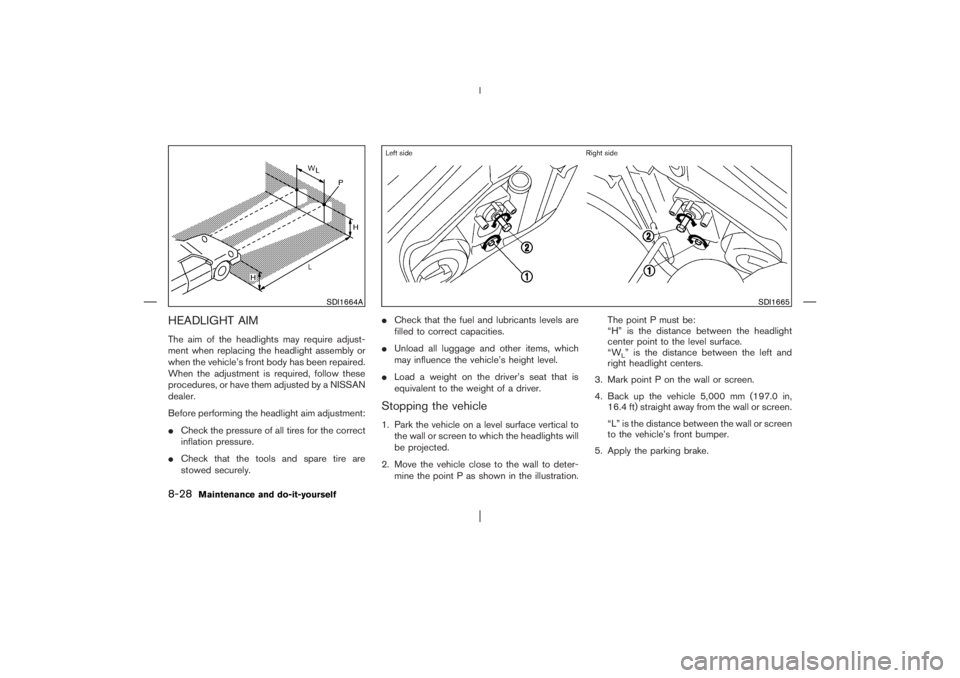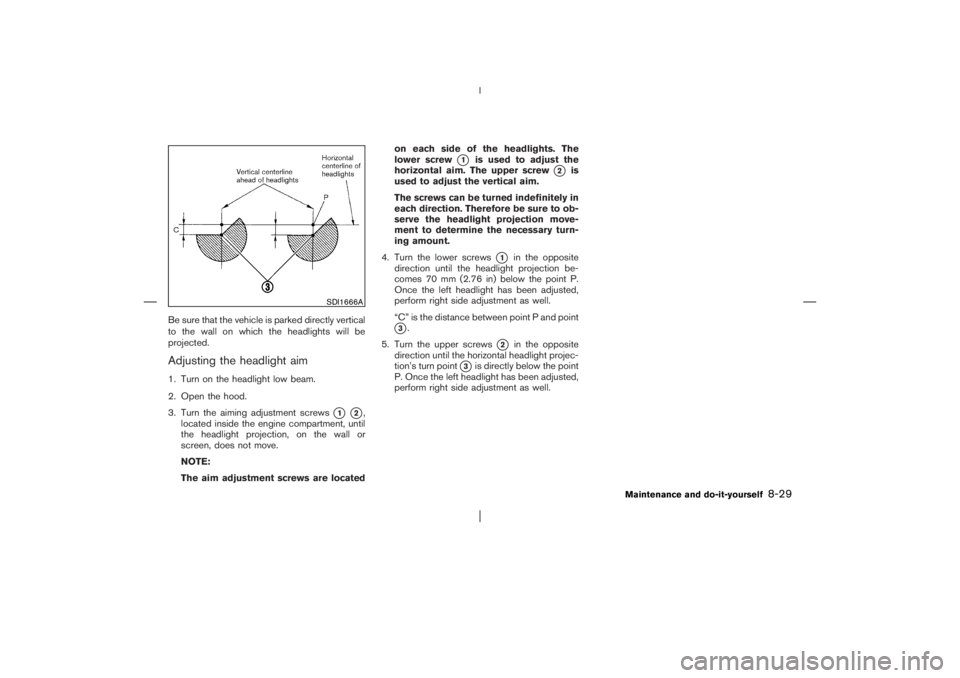Page 224 of 281

CHECKING PARKING BRAKEFrom the released position, pull the parking
brake lever up
�Aslowly and firmly. If the number
of clicks is out of the range listed below, see a
NISSAN dealer.
Pulling force:
196 N (20 kg, 44 lb)
Range:
6 to 7 clicks
CHECKING BRAKE PEDALWith the engine running, check the distance
�A
between the upper surface of the pedal and the
metal floor. If it is out of the range listed below,
see a NISSAN dealer.
Depressing force:
490 N (50 kg, 110 lb)
Range:
85 mm (3.35 in) or more (AT model)
80 mm (3.15 in) or more (MT model)
Self-adjusting brakesYour vehicle is equipped with self-adjusting
brakes.
The disc-type brakes self-adjust every time the
brake pedal is applied.
WARNING
See a NISSAN dealer and have it
checked if the brake pedal height does
not return to normal.Brake pad wear indicatorsThe disc brake pads on your vehicle have au-
dible wear indicators. When a brake pad re-
quires replacement, it will make a high pitched
scraping or screeching sound when the vehicle
is in motion whether or not the brake pedal is
depressed. Have the brakes checked as soon as
possible if the wear indicator sound is heard.
Under some driving or climate conditions, occa-
sional brake squeak, squeal or other noise may
be heard. Occasional brake noise during light to
moderate stops is normal and does not affect
the function or performance of the brake system.
Proper brake inspection intervals should
SDI1447B
DI1020MR
PARKING BRAKE AND BRAKE
PEDAL
Maintenance and do-it-yourself
8-21
�
06.4.14/T30-J/V5.0
�
Page 226 of 281
ENGINE COMPARTMENT
CAUTION
Never use a fuse of higher or lower
amperage rating than that specified on
the fuse box cover. This could damage
the electrical system or cause a fire.If any electrical equipment does not operate,
check for an open fuse.
1. Be sure the ignition switch and headlight
switch are OFF.
2. Open the engine hood.
3. Remove the fusible link cover.
4. Remove the fuse with the fuse puller.
5. If the fuse is open
�A, replace it with a new
fuse
�B.
6. If a new fuse also opens, have the electrical
system checked and repaired by a NISSAN
dealer.
Fusible linksIf any electrical equipment does not operate and
fuses are in good condition, check the fusible
links. If any of these fusible links are melted,
replace only with genuine NISSAN parts.
SDI1928
SDI1753
Type A
SDI1754
Type B
Maintenance and do-it-yourself
8-23
�
06.4.14/T30-J/V5.0
�
Page 227 of 281
PASSENGER COMPARTMENTIf any electrical equipment does not operate,
check for an open fuse.
1. Be sure the ignition key and the headlight
switch are OFF.
2. Pull to open the fuse box lid.
3. Pinch the fuse straight with the fuse puller
�A
and pull it out.
4. If the fuse is open, replace it with a new fuse.
5. If a new fuse also opens, have the electrical
system checked and repaired by a NISSAN
dealer.Replace the battery as follows:
1. Open the lid using a suitable tool
�A.
2. Replace the battery with a new one.
Recommended battery: CR2025 or equiva-
lent
SDI1934
SPA1374E
KEYFOB BATTERY
REPLACEMENT
8-24
Maintenance and do-it-yourself
�
06.4.14/T30-J/V5.0
�
Page 229 of 281
1. Clearance light
2. Headlight/Daytime running light
3. Front turn signal light/Front park light
4. Front fog light (if so equipped)
5. Map light/Room light
6. Side turn signal light
7. Driving light (if so equipped)
8. Front side marker light
9. Room light
10. Stop/tail light
11. Luggage room light
12. Rear turn signal light
13. High-mounted stop light
14. Back-up light
15. License plate light
16. Step light
17. Rear side marker light
SDI1933
LIGHTS8-26
Maintenance and do-it-yourself
�
06.4.14/T30-J/V5.0
�
Page 230 of 281

HEADLIGHTS
ReplacingThe headlight is a semi-sealed beam type which
uses a replaceable headlight (halogen) bulb. A
bulb can be replaced from inside the engine
compartment without removing the headlight
assembly.
CAUTION
�High pressure halogen gas is sealed
inside the halogen bulb. The bulb
may break if the glass envelope is
scratched or the bulb is dropped.
�When handling the bulb, do not touch
the glass envelope.
�Do not touch the bulb.
�Use the same number and wattage as
originally installed:
Bulb no. (Wattage)
H4 (60/55W) - Halogen low/high-
beam
�Do not leave the bulb out of theheadlight reflector for a long period
of time as dust, moisture, and smoke
may enter the headlight body and
affect the performance of the head
light.
1. Disconnect the battery negative cable.
2. Disconnect the electrical connector from the
rear end of the bulb.
3. Pull off the rubber cap
�1.
4. Push and turn the retaining pin
�2
to loosen
it.
5. Remove the headlight bulb. Do not shake or
rotate the bulb when removing it.
6. Install the new bulb in the reverse order of
removal.
SDI1946
Maintenance and do-it-yourself
8-27
�
06.4.14/T30-J/V5.0
�
Page 231 of 281

HEADLIGHT AIMThe aim of the headlights may require adjust-
ment when replacing the headlight assembly or
when the vehicle’s front body has been repaired.
When the adjustment is required, follow these
procedures, or have them adjusted by a NISSAN
dealer.
Before performing the headlight aim adjustment:
�Check the pressure of all tires for the correct
inflation pressure.
�Check that the tools and spare tire are
stowed securely.�Check that the fuel and lubricants levels are
filled to correct capacities.
�Unload all luggage and other items, which
may influence the vehicle’s height level.
�Load a weight on the driver’s seat that is
equivalent to the weight of a driver.
Stopping the vehicle1. Park the vehicle on a level surface vertical to
the wall or screen to which the headlights will
be projected.
2. Move the vehicle close to the wall to deter-
mine the point P as shown in the illustration.The point P must be:
“H” is the distance between the headlight
center point to the level surface.
“W
L” is the distance between the left and
right headlight centers.
3. Mark point P on the wall or screen.
4. Back up the vehicle 5,000 mm (197.0 in,
16.4 ft) straight away from the wall or screen.
“L” is the distance between the wall or screen
to the vehicle’s front bumper.
5. Apply the parking brake.
SDI1664A
SDI1665
8-28
Maintenance and do-it-yourself
�
06.4.14/T30-J/V5.0
�
Page 232 of 281

Be sure that the vehicle is parked directly vertical
to the wall on which the headlights will be
projected.Adjusting the headlight aim1. Turn on the headlight low beam.
2. Open the hood.
3. Turn the aiming adjustment screws
�1
�2,
located inside the engine compartment, until
the headlight projection, on the wall or
screen, does not move.
NOTE:
The aim adjustment screws are locatedon each side of the headlights. The
lower screw
�1
is used to adjust the
horizontal aim. The upper screw
�2
is
used to adjust the vertical aim.
The screws can be turned indefinitely in
each direction. Therefore be sure to ob-
serve the headlight projection move-
ment to determine the necessary turn-
ing amount.
4. Turn the lower screws
�1
in the opposite
direction until the headlight projection be-
comes 70 mm (2.76 in) below the point P.
Once the left headlight has been adjusted,
perform right side adjustment as well.
“C” is the distance between point P and point
�3.
5. Turn the upper screws
�2
in the opposite
direction until the horizontal headlight projec-
tion’s turn point
�3is directly below the point
P. Once the left headlight has been adjusted,
perform right side adjustment as well.
SDI1666A
Maintenance and do-it-yourself
8-29
�
06.4.14/T30-J/V5.0
�
Page 233 of 281
EXTERIOR AND INTERIOR LIGHTS
Item Wattage (W) BulbNo.
Front turn signal light 21 T20
Front park light 5 T20
Side turn signal light 5 T10
Driving light (if so equipped)* 65 H1
Front side marker light 5 T10
Front fog light (if so equipped)* 55 H11
Rear combination light*
Turn signal 21 S25
Stop/Tail 21/5 T20
Back-up 21
License plate light 5 T10
High-mounted stop light 5
Room light 10
Map light 8
Luggage room light 10
Step light* 2.7 161
Rear side marker light 5 T10
*: See a NISSAN dealer for replacement.
SDI1685
8-30
Maintenance and do-it-yourself
�
06.4.14/T30-J/V5.0
�